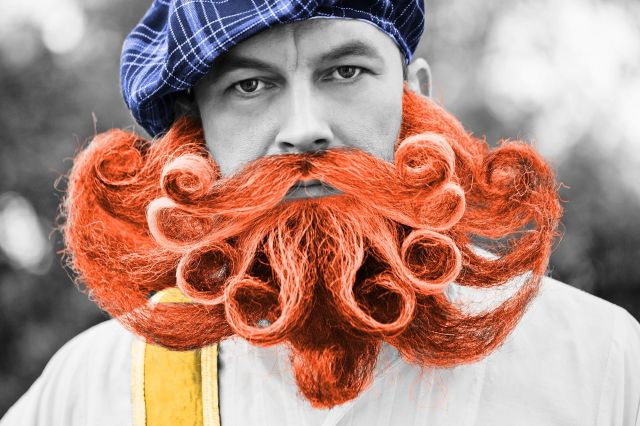
Crying Baby Festival (Various Locations, Japan)
Every year, babies all over Japan face off in a daring competition to see who cries first. Don’t worry — it’s a sign of good health! The Naki Sumo Festival, related to a proverb that translates as “crying babies grow fast,” dates back more than 400 years (about 30 in its modern form). Part of the idea is that a loud cry from a baby will scare off demons, allowing the child to grow up strong and healthy. The tradition works a little differently in different areas, but the basic idea is that two babies enter a sumo ring, sometimes carried by sumo wrestlers, sometimes dressed as adorable little sumo wrestlers themselves. Then the wrestlers try to make the babies cry by making faces and sometimes wearing oni masks to make themselves look like demons. In the event of a tie, victory goes to the louder baby.

Bee Bearding (Various Locations)
Most people try to avoid bees if they can. Bee bearders, on the other hand, want to attract as many bees as possible to land on their bodies. And no, they don’t typically end up covered in stings.
The bees are mellowed out first with a steady diet of sugar syrup. The queen is placed in a vial and placed around the neck of the bearder. Then, the docile bees start gently swarming, attracted by her pheromones. Because it’s hard to count that many bees, wins and records are recorded by weight. One winner at a festival in Canada in 2013 ended up with 3.8 pounds of bees on him, an estimated 15,000 insects. It seems like a lot, but it’s only a fraction of what a beekeeper in China accomplished during a 2011 competition, with 59 pounds of bees covering his body. The world record was set in 2016, when a beekeeper used 60 queens to attract more than 140 pounds of bees.
Getting wrapped in a big bee hug is not a competition for everybody — but it’s sometimes used as a teaching tool to show that bees can be friendly.

Fat Bear Week (Alaska and Online)
As winter approaches, bears have to prepare for hibernation by packing on some serious pounds — once they settle in, most won’t eat anything at all for months. So each October, as the bears in Katmai National Park in Alaska finish fattening up for the winter, they’re (unknowingly) pitted against each other in a tournament-style bracket called Fat Bear Week. The public watches online bear cams and attends virtual educational events, and then votes in online polls to decide who wins. Starting in 2021, the National Park Service added a second bracket called Fat Bear Junior, tracking the cubs that were born the previous spring. The 2023 winner was Grazer, an extremely defensive mother bear who is known to successfully confront much larger bears. (She also got very fat.)
More Interesting Reads

Cheese Rolling (Gloucestershire, England)
Each year in late May, hundreds, sometimes thousands, gather in Gloucestershire, England, just outside of the village of Brockworth to watch competitors chase a 7-pound wheel of cheese 200 yards down a 26-degree hill. The event dates back to at least the 19th century, and a single local cheesemaker has provided the cheese for 25 years. Locals are so devoted to the tradition that one year when the official race was canceled, around 1,000 people gathered to put on the event anyway.
It may sound quaint, but competition is stiff, and the fastest cheese-chasers often end the race with injuries. One competitor who has won multiple races has walked away with a broken ankle and bruised kidneys before.

Shin Kicking (Also in Gloucestershire, England)
Just 45 minutes away from the cheese-rolling competition and around the same time, the small village of Chipping Campden hosts the annual Cotswold Olympick Games, which hearken back to the 17th century (although not continuously). The silliest of the games, which also dates back hundreds of years, is shin kicking, which is exactly what it sounds like.
According to the games’ organizers, shin kicking evolved from Cotswold wrestling, where two wrestlers with their hands on each other’s shoulders try to trip or throw each other on the ground. Eventually, the tripping part became the main part of the sport and evolved into kicking. Today, anyone can compete in shin kicking at the Olympicks.

Frozen Tuna Throwing (Port Lincoln, Australia)
For six decades (with a break for two years during the COVID-19 pandemic), the residents of the Eyre Peninsula in southern Australia have celebrated seafood with the annual Tunarama Festival. Since 1979, that’s involved the Tuna Toss, a reference to the days when fishermen would literally have to throw their catches onto trucks from the dock. For 30 years competitors threw actual frozen tuna, but in 2008 they switched to a weighted plastic replica for the initial heats. The festival stopped in 2023 due to funding challenges, but local officials haven’t ruled out a revival.

Frozen Dead Guy Days (Nederland, Colorado)
About 17 miles west and 2,900 feet above Boulder, Colorado, you’ll come across a plastic utility shed with the body of a Norwegian man kept packed in dry ice. It turns out the deceased and his offspring were big believers in cryonics, wherein dead bodies are kept in a deep freeze, awaiting future medical advances that could allow them to be brought back to life. There was a problem for this particular dead body, though: The daughter and grandson who had been caretakers for the frozen man since 1993 came upon hard times and both returned to Norway. The town of Nederland, seeing an opportunity for offbeat fame, took up the cause of keeping the late Mr. Morstoel from thawing. In 2003, they began to celebrate their local stiff with Frozen Dead Guy Days, an annual March event.
Locals have devised numerous thematic competitions during the festival that share a macabre humor. These include hearse races, coffin races (six “pallbearers” carry a coffin with a live person in it, racing other groups through an obstacle course), a polar plunge, a game of rigid-human foosball played on a snowy field, a brain freeze contest (contestants race to finish frozen drinks), frozen fish toss, and frozen turkey bowling. The funereal fun is kept alive all weekend through Day of the Dead costumes, a live musical, and a Blue Ball dance.

World’s Ugliest Dog Contest (Petaluma, California)
What began in the mid-1970s as a minor sideshow-esque contest at the annual Sonoma-Marin Fair in Northern California has become an annual tour de force, drawing more spectators than any other element of the fair. The often lopsided, fuzzy, popeyed winners of the World’s Ugliest Dog title often receive front-page coverage in the national press.
Despite the contest’s name, the mood of the annual June competition is more celebratory and loving than you may expect. Most of the dogs entered in the contest were adopted by their proud owners from animal shelters or rescue groups, and the lucky pooches are often greeted with noisy and indulgent “oohs” and “ahhs.” Wiry head tufts, lolling tongues, hairless tails, cloudy eyes — should you have the luck to attend one of the late June contests (and lovefests), be forewarned: You may come down with an unavoidable need to adopt a funny-looking pet.

World’s Beard and Mustache Championships (Various Locations)
Perhaps you didn’t know that there’s a sport that calls itself “bearding,” or that websites and grooming companies exist that cater to “beard-os” or “beardaholics.” Some people obviously take great pride in growing, teasing, and training their facial hair. Or maybe you did know all these things and have been following the growth in popularity for the hirsute, with professional baseball players, purveyors of craft cocktails, country music stars, and hipsters everywhere contributing to the trend. Either way, where there’s pride and attention paid, it follows that a competition can’t be far behind.
In fact, there are loads of beard and mustache contests — ones held in local bars or ones sponsored by beard oil makers — but the fathership of the facial hair competitions is the World’s Beard and Mustache Championships. The WBMC pops up every two years in a different location around Europe, the U.S., or Australia. This officially sanctioned event offers titles in 16 different categories for configurations that include mustaches, partial beards, and full beards.
In all divisions, there’s a natural competition for those who eschew hot combs, styling wax, and curling irons. But if you prefer a little creative use of product and equipment with your facial hair, you’re in luck. Men sporting quirky Dali mustaches are judged separately from those who wear magnificent Hungarian mustaches. Wearers of musketeers and Fu Manchus and Kaiser beards compete amongst themselves. And for those whose growth defies labels, freestyle competitions bring out the weirdest and most original stylings. The next competition has been pushed back to April 2023 — thus, if you’re so inclined, there’s plenty of time to stop shaving and be hairy enough to join the competition in Auckland.

Bog Snorkeling (Wales)
Imagine the sight of the starting blocks at an Olympic swimming competition: the athletes in their streamlined suits, the pool shimmering and clear, everyone quiet and focused, awaiting the blare of the starting buzzer. Now set that image aside. This, instead, is bog-snorkeling, an absurd contest invented in 1986 in Wales (though now practiced by silly people throughout the world). Instead of pristine starting blocks, there’s a wooden walkway that crosses a 197-foot-long trench dug in a peat bog in Wales. Participants, wearing ungainly flippers and snorkels, lower themselves from that walkway into cold and muddy water and then, one at a time, make their way down the length of the waterway and back, without using any recognizable swimming strokes. Their supporters and competitors string out along the trench, wearing galoshes against the mud and often carrying umbrellas against the Welsh summer weather — cheering, heckling the splashy progress, and drinking local ale.
In addition to a contest for speed, some compete for best costume or bog accessory, while others make matters more difficult by adding triathlon components to the bog swim. Besides being a giddy celebration of summer, the bog snorkeling serves as a charity fundraiser, so the contestants can feel better when they are still finding traces of mud in their ears a week later.












